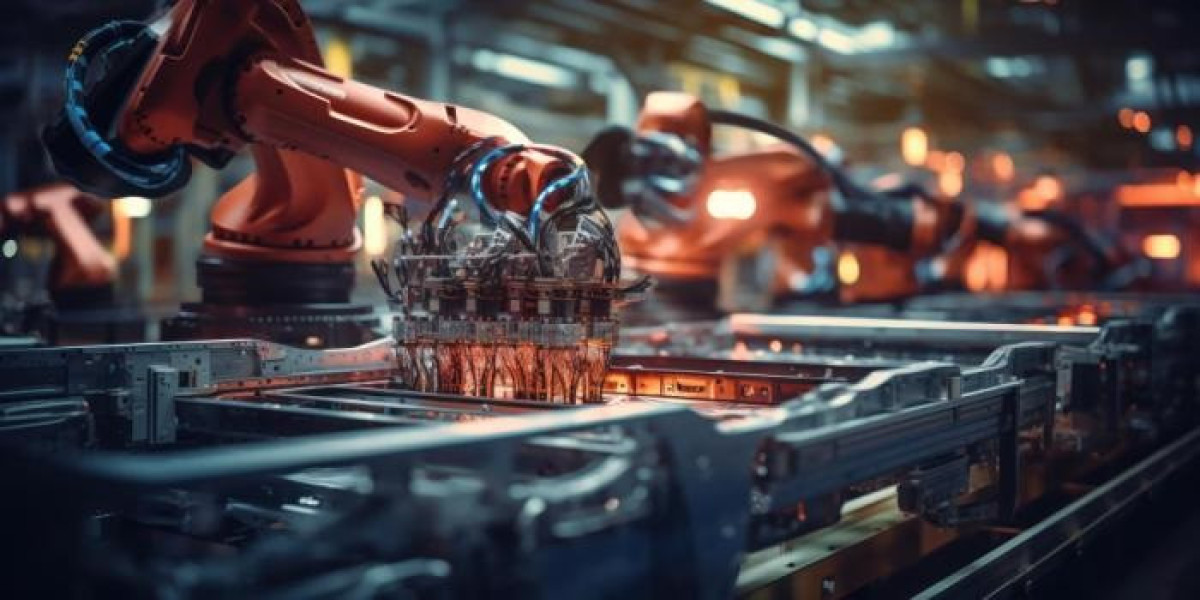Introduction
The manufacturing sector has always been a cornerstone of economic development and technological progress. In recent years, this industry has undergone a significant transformation driven by innovative IT solutions for manufacturing and the integration of the Internet of Things (IoT) in manufacturing processes. These technological advancements are revolutionizing production methods, improving efficiency, and opening new avenues for growth and competitiveness. This article explores the pivotal role of IT solutions and IoT in the digital transformation of the manufacturing industry.
The Evolution of IT Solutions in Manufacturing
Historical Context
The journey of IT solutions for manufacturing began with the introduction of computer-aided design (CAD) and computer-aided manufacturing (CAM) systems in the 1960s and 1970s. These early innovations laid the groundwork for more sophisticated technologies, enabling manufacturers to design and produce complex products with greater precision.
Modern IT Solutions
Today, IT solutions in manufacturing encompass a wide range of technologies, including enterprise resource planning (ERP) systems, manufacturing execution systems (MES), supply chain management (SCM) software, and predictive analytics. These solutions have become integral to modern manufacturing operations, facilitating real-time decision-making, optimizing resource allocation, and enhancing product quality.
The Role of IoT in Manufacturing
Defining IoT in Manufacturing
IoT in manufacturing refers to the network of interconnected devices and systems that communicate and exchange data to improve manufacturing processes. These devices include sensors, actuators, and smart machines that collect and analyze data to enable real-time monitoring and control.
Benefits of IoT Integration
The integration of IoT in manufacturing offers numerous benefits, including:
- Enhanced Operational Efficiency: IoT devices provide real-time data on equipment performance, allowing manufacturers to identify and address inefficiencies promptly.
- Predictive Maintenance: By monitoring machine health and predicting failures before they occur, IoT helps reduce downtime and maintenance costs.
- Improved Quality Control: IoT-enabled quality control systems ensure that products meet stringent quality standards by monitoring production processes continuously.
- Supply Chain Optimization: IoT enhances supply chain visibility, enabling manufacturers to track inventory, optimize logistics, and reduce lead times.
IT Solutions for Manufacturing: Key Innovations
Advanced ERP Systems
Enterprise resource planning (ERP) systems are the backbone of modern manufacturing operations. These systems integrate various business processes, including production, inventory management, procurement, and finance, into a unified platform. Advanced ERP systems offer features such as real-time analytics, mobile access, and cloud-based deployment, making them indispensable for manufacturers aiming to streamline operations and improve decision-making.
Manufacturing Execution Systems (MES)
Manufacturing execution systems (MES) bridge the gap between the production floor and enterprise-level systems. MES solutions provide real-time data on production activities, enabling manufacturers to monitor and control every aspect of the manufacturing process. Key features of MES include:
- Production Scheduling: Optimizing production schedules to maximize efficiency and meet customer demand.
- Quality Management: Ensuring products meet quality standards through real-time monitoring and control.
- Traceability: Tracking materials and components throughout the production process for compliance and quality assurance.
Supply Chain Management (SCM) Software
Effective supply chain management is crucial for manufacturing success. SCM software solutions enable manufacturers to manage their supply chains more efficiently by providing visibility into every stage of the process. Key features of SCM software include:
- Inventory Management: Optimizing inventory levels to reduce costs and meet demand.
- Logistics Optimization: Improving transportation and distribution efficiency.
- Supplier Collaboration: Enhancing communication and collaboration with suppliers to ensure timely delivery of materials.
Predictive Analytics and AI
Predictive analytics and artificial intelligence (AI) are transforming manufacturing by providing insights that were previously unattainable. These technologies analyze vast amounts of data to identify patterns and predict future outcomes. Applications of predictive analytics and AI in manufacturing include:
- Predictive Maintenance: Anticipating equipment failures and scheduling maintenance to prevent downtime.
- Demand Forecasting: Predicting customer demand to optimize production and inventory levels.
- Quality Control: Identifying potential quality issues before they impact production.
IoT in Manufacturing: Key Applications
Smart Factories
Smart factories represent the pinnacle of IoT integration in manufacturing. These highly automated and interconnected facilities leverage IoT devices to monitor and control every aspect of production. Key components of smart factories include:
- IoT Sensors: Collecting real-time data on machine performance, environmental conditions, and product quality.
- Industrial Robots: Performing repetitive and complex tasks with precision and consistency.
- Digital Twins: Creating virtual replicas of physical assets to simulate and optimize production processes.
Predictive Maintenance
Predictive maintenance is one of the most impactful applications of IoT in manufacturing. By continuously monitoring machine health and performance, IoT devices can predict when equipment is likely to fail. This allows manufacturers to schedule maintenance proactively, reducing downtime and maintenance costs.
Quality Control
IoT-enabled quality control systems use sensors and cameras to monitor production processes in real-time. These systems can detect defects and deviations from quality standards, allowing manufacturers to address issues promptly and maintain high product quality.
Supply Chain Management
IoT enhances supply chain management by providing real-time visibility into inventory levels, shipments, and logistics. This enables manufacturers to optimize their supply chains, reduce lead times, and respond quickly to changes in demand.
Energy Management
Energy consumption is a significant cost for manufacturers. IoT devices can monitor energy usage across the production facility, identifying areas where energy can be saved. This not only reduces costs but also supports sustainability initiatives.
Case Studies: Real-World Examples of IT Solutions and IoT in Manufacturing
Siemens’ Smart Factory
Siemens, a global leader in manufacturing technology, has embraced IoT and advanced IT solutions to create a smart factory in Amberg, Germany. The factory is highly automated, with over 1,000 IoT sensors and devices monitoring production processes. The integration of IoT and IT solutions has resulted in a 99.99885% product quality rate and a 75% reduction in production time.
General Electric’s Predictive Maintenance
General Electric (GE) has implemented IoT-based predictive maintenance solutions across its manufacturing facilities. By monitoring machine health and performance in real-time, GE has been able to reduce unplanned downtime by 20% and maintenance costs by 10%.
Harley-Davidson’s Flexible Manufacturing System
Harley-Davidson, the iconic motorcycle manufacturer, has adopted a flexible manufacturing system enabled by advanced IT solutions and IoT. The system allows the company to produce customized motorcycles in real-time, reducing production lead times from 21 days to just six hours.
Challenges and Solutions in Implementing IT and IoT in Manufacturing
Data Security and Privacy
The integration of IoT and IT solutions in manufacturing raises concerns about data security and privacy. Manufacturers must implement robust cybersecurity measures to protect sensitive data from cyber threats. Solutions include:
- Encryption: Protecting data in transit and at rest using advanced encryption techniques.
- Access Control: Restricting access to sensitive data to authorized personnel only.
- Regular Audits: Conducting regular security audits to identify and address vulnerabilities.
Integration with Legacy Systems
Many manufacturers still rely on legacy systems that may not be compatible with modern IT solutions and IoT devices. To address this challenge, manufacturers can:
- Use Middleware: Employ middleware solutions to facilitate communication between legacy systems and new technologies.
- Gradual Integration: Implement IT solutions and IoT devices gradually, starting with pilot projects and scaling up over time.
- Training and Support: Provide training and support to employees to ensure a smooth transition to new technologies.
Cost and ROI
The implementation of IT solutions and IoT in manufacturing requires significant investment. Manufacturers must carefully evaluate the cost and potential return on investment (ROI) before embarking on digital transformation initiatives. Strategies to maximize ROI include:
- Prioritizing High-Impact Areas: Focus on areas where IT solutions and IoT can deliver the most significant benefits, such as predictive maintenance and quality control.
- Leveraging Government Incentives: Take advantage of government incentives and grants for digital transformation projects.
- Collaborating with Technology Partners: Partner with technology providers to share the costs and benefits of implementing new technologies.
Workforce Training and Adaptation
The adoption of IT solutions and IoT in manufacturing requires a skilled workforce capable of managing and maintaining these technologies. Manufacturers must invest in workforce training and development to ensure employees have the necessary skills. Approaches include:
- On-the-Job Training: Provide hands-on training to employees to help them learn how to use new technologies effectively.
- Partnerships with Educational Institutions: Collaborate with universities and technical schools to develop specialized training programs.
- Continuous Learning: Encourage a culture of continuous learning and development to keep up with technological advancements.
The Future of IT Solutions and IoT in Manufacturing
Emerging Technologies
The future of IT solutions and IoT in manufacturing will be shaped by emerging technologies such as:
- 5G Connectivity: The deployment of 5G networks will enable faster and more reliable communication between IoT devices, enhancing real-time monitoring and control.
- Edge Computing: By processing data closer to the source, edge computing will reduce latency and improve the performance of IoT applications.
- Artificial Intelligence and Machine Learning: AI and machine learning will continue to drive innovation in predictive maintenance, quality control, and process optimization.
Increased Adoption of Smart Manufacturing
The trend towards smart manufacturing is expected to accelerate in the coming years. As more manufacturers recognize the benefits of IoT and advanced IT solutions, we can expect to see:
- Greater Automation: Increased use of industrial robots and automated systems to improve efficiency and reduce labor costs.
- Enhanced Collaboration: Improved collaboration between manufacturers, suppliers, and customers through interconnected systems and real-time data sharing.
- Sustainability Initiatives: Adoption of green manufacturing practices supported by IoT and IT solutions to reduce environmental impact and improve sustainability.
Challenges and Opportunities
While the future of IT solutions and IoT in manufacturing is promising, manufacturers will face challenges such as:
- Cybersecurity Threats: As the number of connected devices increases, so does the risk of cyberattacks. Manufacturers must stay vigilant and invest in robust cybersecurity measures.
- Skill Shortages: The demand for skilled workers capable of managing advanced technologies will continue to grow. Manufacturers must address skill shortages through training and development programs.
- Regulatory Compliance: Compliance with evolving regulations related to data privacy, security, and environmental standards will be crucial for manufacturers adopting new technologies.
Despite these challenges, the opportunities presented by IT solutions and IoT in manufacturing are immense. By embracing digital transformation, manufacturers can achieve unprecedented levels of efficiency, quality, and innovation.
Conclusion
Innovative IT solutions and IoT are driving the digital transformation in manufacturing, revolutionizing the way products are designed, produced, and delivered. The integration of advanced technologies such as ERP systems, MES, predictive analytics, and IoT devices is enabling manufacturers to optimize operations, enhance quality, and reduce costs. As the industry continues to evolve, manufacturers that embrace these innovations will be well-positioned to thrive in an increasingly competitive and dynamic market. The future of manufacturing is digital, and the journey towards this future is already well underway.



